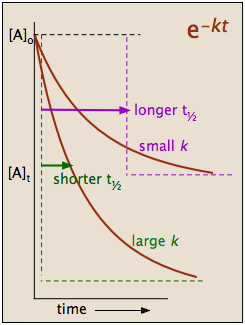The First-order Rate Law (Integral Form) calculator computes the concentration of a substance (A) based on a Rate Law equation, the initial concentration (A0), the rate constant (k) and the duration of the reaction (s).
INSTRUCTIONS: Choose units and enter the following:
- [A0] Initial Concentration of the Substance.
- (k) Rate Constant.
- (s) Duration of the Reaction.
Concentration of Substance [A]: The calculator returns the concentration of the substance after the reaction in moles per liter (mol/L). However, this can be automatically converted to other concentration units via the pull-down menu. 
Chemistry Rate Law Calculators
- Zero Order Rate Law (Integral form)
- Zero Order Half Life
- Zero Order Rate Law
- First Order Rate Law (Integral form)
- First Order Half Life
- First Order Rate Law
- Second Order Rate Law (Integral form)
- Second Order Half Life
- Second Order Rate Law
The Science
The first order rate integral[1] equation calculates the rate at which the reactants turn in to products. Unlike the differential form of the first-order equation, the integral form looks at the amount of reactants have been converted to products at a specific point in the reaction. A full integration of the equation can be found here.
The Math
The equation for the first-order rate reaction is
[A]=[A]oe−kt [2]
Where:
- [A] is the concentration of substance after reaction.
- [A]o is the initial concentration in units of (mol/L)
- k is the rate constant in units of (1/sec)
- t is time of the concentration (sec
Related Topics
Supplement Material
- Khan Academy: Rate law and reaction order
References
[1] https://en.wikipedia.org/wiki/Rate_equation
[2]Whitten, et al. 10th Edition. Pp. 626,629,631
[Picture]http://chemwiki.ucdavis.edu/Core/Physical_Chemistry/Kinetics/Reaction_Rates/First-Order_Reactions
